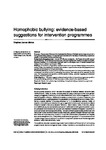Homophobic bullying: evidence-based suggestions for intervention programmes
| dc.contributor.author | James Minton, S | |
| dc.date.accessioned | 2019-10-22T12:30:26Z | |
| dc.date.available | 2019-10-22T12:30:26Z | |
| dc.date.issued | 2014-07-08 | |
| dc.identifier.issn | 1759-6599 | |
| dc.identifier.issn | 2042-8715 | |
| dc.identifier.uri | http://hdl.handle.net/10026.1/15013 | |
| dc.description.abstract |
<jats:sec> <jats:title content-type="abstract-heading">Purpose</jats:title> <jats:p> – The purpose of this paper is to investigate the influence of the basic factors of age and gender in homophobic bullying behaviour, in order that recommendations for the design of anti-bullying programmes specific to homophobic bullying could be made. </jats:p> </jats:sec> <jats:sec> <jats:title content-type="abstract-heading">Design/methodology/approach</jats:title> <jats:p> – In total, 475 fifth year students (ca. 16-17 years old) and 561-second year students (ca. 13-14 years old) at six secondary schools in the Republic of Ireland completed an English-language translation of a questionnaire previously used in a Norwegian study of sexual orientation and bullying behaviour (Roland and Auestad, 2009). </jats:p> </jats:sec> <jats:sec> <jats:title content-type="abstract-heading">Findings</jats:title> <jats:p> – No evidence of “age-related declines” were found in reports of either bullying or homophobic bullying. Males were significantly more likely than females to report involvement (as both perpetrators and targets) in both bullying and homophobic bullying. </jats:p> </jats:sec> <jats:sec> <jats:title content-type="abstract-heading">Practical implications</jats:title> <jats:p> – It was concluded that senior secondary school students, as well as their younger counterparts, should be involved in anti-bullying interventions; that males should be especially focused upon; and that programmes specific to anti-homophobic bullying, potentially targeting pre-adolescent students, should be supported. </jats:p> </jats:sec> <jats:sec> <jats:title content-type="abstract-heading">Originality/value</jats:title> <jats:p> – This paper suggests evidence-based priorities for intervention programmes specific to homophobic bullying, accounts of which have been, to date, absent in the research literature.</jats:p> </jats:sec> | |
| dc.format.extent | 164-173 | |
| dc.language | en | |
| dc.language.iso | en | |
| dc.publisher | Emerald | |
| dc.subject | 44 Human Society | |
| dc.subject | 52 Psychology | |
| dc.subject | 4410 Sociology | |
| dc.subject | 5201 Applied and Developmental Psychology | |
| dc.subject | Violence Research | |
| dc.subject | Mental health | |
| dc.title | Homophobic bullying: evidence-based suggestions for intervention programmes | |
| dc.type | journal-article | |
| dc.type | Journal Article | |
| plymouth.issue | 3 | |
| plymouth.volume | 6 | |
| plymouth.publication-status | Published | |
| plymouth.journal | Journal of Aggression, Conflict and Peace Research | |
| dc.identifier.doi | 10.1108/jacpr-10-2013-0027 | |
| plymouth.organisational-group | /Plymouth | |
| plymouth.organisational-group | /Plymouth/Faculty of Health | |
| plymouth.organisational-group | /Plymouth/Faculty of Health/School of Psychology | |
| plymouth.organisational-group | /Plymouth/REF 2021 Researchers by UoA | |
| plymouth.organisational-group | /Plymouth/REF 2021 Researchers by UoA/UoA04 Psychology, Psychiatry and Neuroscience | |
| plymouth.organisational-group | /Plymouth/Users by role | |
| plymouth.organisational-group | /Plymouth/Users by role/Academics | |
| dc.identifier.eissn | 2042-8715 | |
| dc.rights.embargoperiod | Not known | |
| rioxxterms.versionofrecord | 10.1108/jacpr-10-2013-0027 | |
| rioxxterms.licenseref.uri | http://www.rioxx.net/licenses/all-rights-reserved | |
| rioxxterms.type | Journal Article/Review |


